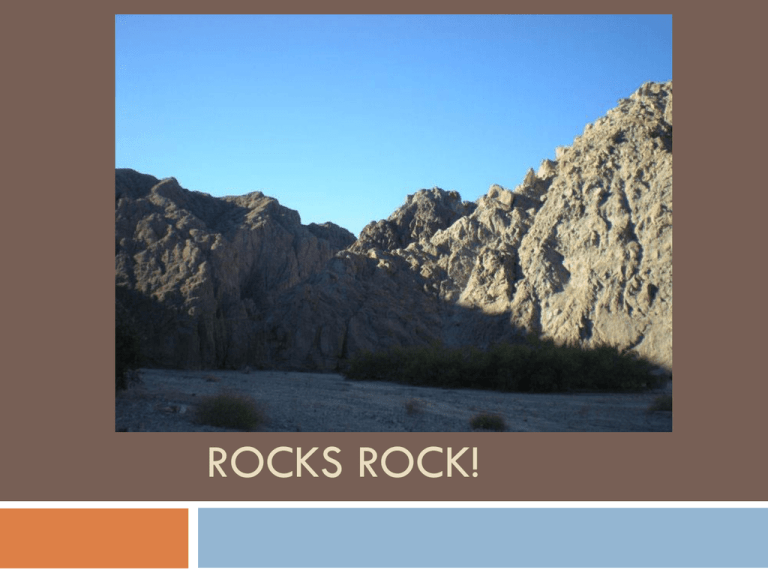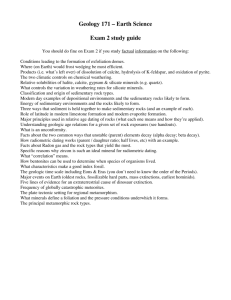ROCKS Rock! - Cloudfront.net
advertisement

ROCKS ROCK! Earth’s Layers Compare & Contrast Rocks! Look at the rock samples and write a short paragraph ( at least 5 COMPLETE sentences) describing how the rocks are similar and how they are different. What is a ROCK? Solid mass of mineral or mineral-like matter that is naturally occurring Most rocks are made up of more than one mineral Some rocks are made up of no minerals Coal=organic material Three Major Types of Rocks Igneous Intrusive Extrusive Sedimentary Metamorphic The Rock Cycle Interactions among Earth’s water, air, & land can cause rocks to change from one type to another Magma or Lava? Magma is molten material deep beneath Earth’s surface When magma reaches the surface it becomes lava Important Vocabulary to Understand the Rock Cycle Weathering—process by which rocks are physically and chemically broken down by water, air, & living things to produce sediment Sediment—weathered pieces of earth material What drives the rock cycle? Igneous and metamorphic rocks are formed by processes from Earth’s interior heat Sedimentary rocks are produced by processes on and near Earth’s surface Weathering and the movement of weathered materials are external processes powered by energy from the sun & gravity Think! Turn to the person sitting next to you and discuss: What do you notice about the rock cycle? IGNEOUS ROCKS!!! Igneous Rocks Intrusive igneous rocks—form when magma hardens beneath Earth’s surface Extrusive igneous rocks—forms when lava hardens Quick Check How are magma and lava the same? How are they different? Classification of Igneous Rocks Coarse Grained Texture Slow cooling=large crystals Fine Grained Texture Fast cooling=small, interconnected minerals grains Which is coarse grained & which is fine grained? Classification of Igneous Rocks Glass Texture—no time for ions in the lava to arrange into crystals before hardening Randomly distributed ions Porphyritic Texture—rocks with very different-size minerals experience different rates of cooling Classification of Igneous Rocks Granitic Composition—light-colored silicate minerals quartz & feldspar are the main minerals Most granitic rocks contain about 10% dark silicate minerals (such as biotite mica & amphibole) Classification of Igneous Rocks Basaltic Composition—contain many dark silicate minerals & plagioclase feldspar Rich in magnesium & iron Typically darker & denser than granitic rocks because of the iron Make up Earth’s ocean floor Classification of Igneous Rocks Andesitic Composition—between granitic & basaltic At least 25% dark silicate minerals, mainly amphibole, pyroxene, & biotite mica Peridotite—almost entirely dark silicate minerals (olivine & pyroxene) Ultramafic—rare upper mantle at Earth’s surface but much of the Classification of Major Igneous Rocks Rock Joke Break! Sedimentary Rocks!!! Formation of Sedimentary Rock Clastic Sedimentary Rocks—made of weathered bits of rocks and minerals Chemical Sedimentary Rocks—dissolved minerals precipitate from water solutions Clastic Sedimentary Rocks Made of mostly clay minerals & quartz Grouped by size of the sediments Conglomerate=rounded, gravel-size or larger particles Breccia=angular particles Sandstone=sand-sized grains Chemical & Biochemical Sedimentary Rocks Dissolved substances precipitate, or separate, from water solutions Water evaporates or boils off leaving a solid product Ex: limestone, rock salt, chert, flint, and rock gypsum Biochemical Sedimentary Rocks=shells & skeletal remains of organisms that settle to the ocean floor Features of Sedimentary Rock Each layer of sedimentary rock records a period of sediment deposits Fossils are unique to some sedimentary rock Classification of Sedimentary Rocks Metamorphic Rocks!!! Formation of Metamorphic Rocks Existing rocks are changed by heat & pressure What does metamorphism mean? Come up with the best definition possible with the person next to you! Changes form Formation (Continued) Contact morphism=magma intrudes (forces its way into) rock Marble often forms when magma intrudes into limestone Formation (Continued) Regional metamorphism Large areas of rocks are subjected to extreme pressures & temperatures during mountain building Intense changes occur at a large scale level Agents of Metamorphism Heat Provides energy needed to drive chemical reactions Cause existing minerals to recrystallize Magma & change in temperature from depth Pressure (stress) Increases with depth Causes the spaces between mineral grains to close Results in more compact rock with a greater density Reactions in solution Hot solutions promote recrystallization Can deposit new minerals in the rocks Classification of Metamorphic Rocks Foliated metamorphic rocks Layered or banded appearance Nonfoliated metamorphic rocks No banded texture Most contain only one mineral Marble is an example—made up of calcite Classification of Metamorphic Rock Think! Use what you have learned about the rock cycle to explain the following statement: One rock is the raw material for another rock Your friend shows you a rock with distinct layers. How can you and your friend determine if the rock is a sedimentary rock of a metamorphic rock?






